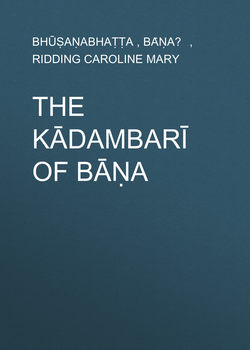Читать книгу The Kādambarī of Bāṇa - Bhūṣaṇabhaṭṭa - Страница 8
INTRODUCTION.1
The Style of ‘Kādambarī.’
ОглавлениеThe unsettled chronology of Indian literature makes it impossible to work out at present Bāṇa’s relations with other Sanskrit writers. Professor Peterson,21 indeed, makes some interesting conjectures as to his connection with other authors of his own country, and also suggests, from similarity of phrase, that he may have fallen indirectly under the influence of Alexandrian literature. Be that as it may, he has been for many centuries a model of style, and it is therefore worth while to consider briefly the characteristics of his style compared with European standards. The first thing that strikes the reader is that the sense of proportion, the very foundation of style as we know it, is entirely absent. No topic is let go till the author can squeeze no more from it. In descriptions every possible minor detail is given in all its fulness; then follows a series of similes, and then a firework of puns. In speeches, be they lamentations or exhortations, grief is not assuaged, nor advice ended, till the same thing has been uttered with every existing variety of synonym. This defect, though it springs from the author’s richness of resource and readiness of wit, makes the task of rendering in English the merit of the Sanskrit style an impossible one. It gives also a false impression; for to us a long description, if good, gives the effect of ‘sweetness long drawn out,’ and, if bad, brings drowsiness; whereas in Sanskrit the unending compounds suggest the impetuous rush of a torrent, and the similes and puns are like the play of light and shade on its waters. Bāṇa, according to Professor Weber,22 ‘passes for the special representative of the Pāñcālī style,’23 which Bhoja, quoted in the commentary of the ‘Sāhitya-Darpaṇa,’ defines as ‘a sweet and soft style characterized by force (ojas) and elegance (kānti), containing compounds of five or six words.’ But style, which is to poetic charm as the body to the soul, varies with the sense to be expressed, and Bāṇa in many of his speeches is perfectly simple and direct. Owing to the peacefulness of ‘Kādambarī,’ there is little opportunity for observing the rule that in the ‘Kathā’ letters ‘ought not to be too rough, even when the flavour is furious.’24 Of the alliteration of initial consonants, the only long passage is in the description of Çukanāsa (p. 50), but in its subtler forms it constantly occurs. Of shorter passages there are several examples —e. g., Candra Caṇḍāla (infra, p. 127); Candrāpīḍa Caṇḍālo (Sanskrit text, p. 416); Utkaṇṭhām sotkaṇṭhaṃ kaṇṭhe jagrāha (Ibid., p. 367); Kāmaṃ sakāmaṃ kuryām (Ibid., p. 350); Candrāpīḍa pīḍanayā (Ibid., p. 370). The ornament of çlesha, or paronomasia, which seems to arise from the untrained philological instinct of mankind seeking the fundamental identity of like sounds with apparently unlike meaning, and which lends dramatic intensity when, as sometimes in Shakespeare,25 a flash of passionate feeling reveals to the speaker an original sameness of meaning in words seemingly far apart, is by Bāṇa used purely as an adornment. He speaks of pleasant stories interwoven with puns ‘as jasmine garlands with campak buds,’ and they abound in his descriptions. The rasanopamā,26 or girdle of similes, is exemplified (p. 115), ‘As youth to beauty, love to youth, spring to love’ so was Kapiñjala to Puṇḍarīka. Vishamaṃ (incongruity) is the figure used in ‘the brightness of his glory, free from heat, consumed his foes; constant, ever roamed’ (p. 48). It can scarcely be separated from virodha (contradiction) – often used, as in ‘I will allay on the funeral pyre the fever which the moon, sandal, and all cool things have increased’ (p. 195) – or from vicitram27 (strangeness), where an act is contrary to its apparent purpose: ‘There lives not the man whom the virtues of the most courteous lady Kādambarī do not discourteously enslave’ (p. 159). Arthāpatti28 (a fortiori conclusion) is exemplified in ‘Even the senseless trees, robed in bark, seem like fellow-ascetics of this holy man. How much more, then, living beings endowed with sense!’ (p. 43). Time and space would alike fail for analysis of Bāṇa’s similes according to the rules of the ‘Sāhitya-Darpaṇa.’29 The author of the ‘Rāghavapāṇḍavīya’ considers Subandhu and Bāṇa as his only equals in vakrokti, or crooked speech, and the fault of a ‘meaning to be guessed out’ (‘Sāhitya-Darpaṇa,’ § 574) is not rare. The ‘Kāvya-Prakāça,’ in addition to the references given by Professor Peterson, quotes a stanza describing a horse in the ‘Harsha-Carita’ (chap. iii.) as an example of svabhāvokti.
The hero belongs to the division described as the high-spirited, but temperate and firm (‘Sāhitya-Darpaṇa,’ § 64), i. e., he who is ‘not given to boasting, placable, very profound, with great self-command, resolute, whose self-esteem is concealed, and faithful to his engagements,’ and who has the ‘eight manly qualities’ of ‘brilliancy, vivacity, sweetness of temper, depth of character, steadfastness, keen sense of honour, gallantry, and magnanimity’ (Ibid., § 89). Kādambarī is the type of the youthful heroine who feels love for the first time, is shy, and gentle even in indignation (Ibid., § 98). The companions of each are also those declared in the books of rhetoric to be appropriate.
21
V. ‘Kādambarī,’ pp. 97–104.
22
V. ‘History of Indian Literature,’ translation, London, 1878, p. 232.
23
V. ‘Sāhitya-Darpaṇa,’ § 626–628.
24
Ibid., § 630.
25
‘Not on thy sole, but on thy soul, harsh Jew,
Thou makest thy knife keen.’
‘Merchant of Venice,’ IV. 1, 123 (Globe edition).
‘Now is it Rome indeed, and room enough,
When there is in it but one only man.’
‘Julius Cæsar,’ I. 2, 156.
26
V. ‘Sāhitya-Darpaṇa,’ § 664.
27
Ibid., § 718–722.
28
Ibid., § 738.
29
V. Peterson, ‘Kādambarī,’ p. 36.
